Python’s robust support for test automation frameworks has significantly contributed to its increasing popularity. Selenium is a widely favored choice for test automation and cross-browser testing in Python environments, seamlessly integrating with many prominent Python frameworks. Selenium Python combination offers a powerful and efficient approach to automating web browser interactions.
This synergy is particularly beneficial for web application testing and various web automation tasks, driven by Python’s simplicity and readability alongside Selenium’s powerful automation capabilities.
Selenium
Selenium automates web browser interactions to test web applications efficiently. It is frequently combined with other software testing tools like JUnit or TestNG to create comprehensive automated tests. Selenium is adaptable enough to carry out functional and performance testing of web applications, including tasks like web app testing for identifying vulnerabilities and ensuring compliance with security standards.
Python Test Automation
Python is a highly effective language for test automation. Test automation uses tools and scripts to perform tests quickly, reducing the need for manual intervention. By writing tests as code, automation allows for faster execution and the reuse of test scripts.
Python is a popular choice among testing teams due to its many features that facilitate automated testing. Its dynamic typing is complemented by static typing checkers like Pyre. Python’s ease of learning and ability to handle complex problems make it accessible to users with different skill levels.
Known for its extensive library support, Python allows testers to avoid writing code from scratch. If an existing library doesn’t meet all your requirements, Python’s flexibility enables easy customization. Additionally, Python’s active community provides valuable support and resources to help overcome any challenges.
Understanding Selenium Python Bindings
Selenium with Python is a robust combination for automating browser interactions and web application testing. This powerful duo allows you to automate tasks such as button clicks, form submissions, and navigation through different parts of a website, streamlining your testing process.
The Selenium Python bindings provide APIs that enable you to write functional tests using Selenium WebDriver. Similar to other Selenium language bindings, these Python APIs help you create efficient tests that interact with WebElements on the Application Under Test (AUT).
These bindings support local browser drivers for browsers like Chrome, Firefox, and Internet Explorer. Additionally, they offer a remote WebDriver, which allows you to connect to a remote cloud-based Selenium Grid for broader testing capabilities.
Why Opt for Python-Based Selenium Learning?
Python is known for its readability and quick coding capabilities, making it easier to write and run scripts rapidly.
- Open Source and Portable: Selenium is a web testing framework that is both open source and portable, offering testers and developers freedom and accessibility.
- Tool and DSL Combination:Selenium combines a number of tools with a Domain Specific Language (DSL) to help users run many tests effectively.
- The logical organization of Selenium commands into distinct classes facilitates their comprehension and use in testing scenarios, hence enhancing their ease of use.
- Less Stress and Burden for Testers:Selenium dramatically cuts down on the time and effort needed for testing, which helps testers by automating repetitive test cases.
- Cost Savings for Businesses:Selenium’s automation testing removes the need for manual testing, which lowers costs for companies.
There are several benefits of learning Selenium with Python for productive and successful web application testing. Combining Selenium with well-known cloud testing services such as LambdaTest amplifies these advantages even more.
With the help of LambdaTest, an AI-powered platform for test orchestration and execution, developers and testers can perform Selenium testing with Python at scale. Users may guarantee thorough testing coverage by gaining access to a remote test lab that includes more than 3000 browsers and operating systems.
Developers and testers can use Selenium Python to write reliable test scripts that automate the testing of online applications and guarantee that they work properly on various platforms and browsers. Furthermore, running tests in parallel on various combinations speeds up the testing process and makes it possible for teams to produce high-quality releases quickly.
Python API for Selenium:
Seamless Integration: The Python API simplifies the connection to browsers using Selenium, providing straightforward APIs for conducting practical and functional tests on Selenium WebDriver.
User-Friendly Language:
- Less Verbose: Python is less verbose compared to other programming languages, making it extremely user-friendly.
- Command Compatibility: Regardless of browser design, Selenium can communicate common Python commands to various browsers effortlessly.
Ease of Library Use:
Straightforward Library: Selenium Python is a relatively easy library to use, which facilitates its adoption and implementation.
Extensible Tools:
Wide Range of Tools: Selenium with Python offers a broad array of tools to extend its functionality, making the WebDriver a strong binding for Python.
Requirements to Execute Python Selenium Scripts
Installing the Selenium package using pip provides a simple starting point for running Selenium tests with Python. In addition, in order to use your preferred online browser, you need to download some drivers. The links to get drivers for browsers like Chrome, Edge, Firefox, and Safari are easily found on the internet. We will be using selenium Chromedriver in this instruction. Once you have the correct driver installed for your browser, continue with Selenium setup and browser installation.
Important to note is that downloading the package and drivers is sufficient if you plan to run Selenium tests only locally. On the other hand, the Selenium Server installation is required if you intend to use Selenium on a remote server. Java is used to write Selenium Server.
How to Run Your First Test with Python and Selenium
In order to launch your first Selenium test with Python, first import the WebDriver and Keys classes from Selenium. The Keys class makes it easier to simulate keyboard keystrokes, and the WebDriver class connects to a browser instance.
Once the Selenium package has been installed and the necessary modules have been imported, launch a new Chrome instance with the driver path that you downloaded from Chrome’s official website or your favorite browser. To load a webpage, use the driver’s.get() method, which by default waits for rendering to be finished before continuing.
After the page loads successfully, use the.title attribute to access the webpage’s title. In the search field, type a query by selecting the relevant HTML DOM element, entering a value,
After the page loads successfully, use the.title attribute to access the webpage’s title. In order to submit a search query in the search bar, choose the relevant HTML DOM element, enter a value, and then simulate pressing the Return key to submit the form.
After these steps, use the.close() method to break the connection with the browser in order to end the current session.
In order to interact with HTML DOM elements, you can further navigate them using different selection options.
Exploring Advanced Techniques and Features with Selenium Python Bindings
Selenium Python bindings present an array of advanced techniques and features that can enhance your test automation initiatives. These functionalities go beyond basic browser interactions, empowering you to address complex scenarios and execute sophisticated interactions. Below are insights into some of the advanced techniques and features available with Selenium Python bindings:
- XPath Locating:
XPath serves as a robust element locator, allowing the identification of elements on web pages using expressions. Particularly useful for dynamic elements or those lacking specific attributes, XPath considers the entire HTML tree structure. When combined with Python, XPath becomes a valuable tool for crafting efficient tests and automation scripts.
- Page Objects:
Page objects introduce an abstraction layer between test logic and UI element details, simplifying automation testing. By centralizing all page elements, page objects enhance code modularity and management, minimizing duplication and improving test organization.
- Understanding Locators and Syntaxes in Selenium:
Effective utilization of locators and syntaxes is critical for successful Selenium automation tests. Selenium’s built-in methods enable precise element location on web pages. To leverage the Selenium library effectively, understanding the distinctions between identifying locators (such as ID, class name, XPath, or link text) and writing syntaxes (using methods like FindElement or FindElements) is essential for robust test creation.
- Setting Up Reports and Generating Results:
Establishing reports to track and document test results is essential for optimizing Selenium automation tests. Reporting libraries like Allure Report or Pytest HTML Report facilitate the generation of detailed reports, encompassing test cases, statuses, logs, and screenshots. Python enables customization of reports using tools like Pandas or Matplotlib, facilitating quick data analysis and issue identification.
- Handling Common Automation Challenges:
Address challenges related to dynamic elements and synchronization using techniques like explicit waits and expected conditions. Implement robust error handling mechanisms to manage unexpected pop-ups or errors encountered during test execution. Adopt design patterns like the Page Object Model (POM) for better test maintenance and scalability.
- Structuring Test Code and Organizing Test Suites:
Organize test code logically by grouping related functionalities into modules or packages, promoting better organization and maintainability. Establish clear test hierarchies using test suites or runners to efficiently manage test cases.
- Implementing Efficient Test Data Management:
Adopt data-driven testing techniques to separate test data from test logic, facilitating easier maintenance and scalability. Store test data externally and dynamically read it during test execution for flexibility and scalability.
- Managing iframes:
Selenium Python bindings provide methods to navigate and interact with elements within iframes, addressing challenges related to embedded content within web pages.
- Mobile app testing:
Extend support for mobile app testing through frameworks like Appium, enabling testing on mobile emulators and real devices compatible with both iOS and Android platforms.
- Custom Waits:
Fine-tune synchronization of test steps and application states using custom waits to reduce the risk of test unreliability stemming from timing issues.
- Parallel Execution:
Leverage parallel testing to maximize test execution efficiency and reduce feedback time, particularly beneficial for extensive test suites.
Enhance parallel execution capabilities with an AI-powered test orchestration and execution platform like LambdaTest for efficient testing across multiple browsers and platforms.
Conclusion
The caliber of the tests you write will determine how effective your testing framework is, and testing process automation can help you save time. As a result, taking the effort to create thorough tests that account for every eventuality is crucial. It is better to find faults during the testing stage than to deal with complaints from customers afterwards.
UI testing is now more accessible and effective thanks to Selenium WebDriver, especially in situations where frequent feature updates are needed and short development cycles are in place. Another big plus for Selenium is its versatility; it works with a broad range of browsers, platforms, and scripting languages, including Ruby, Perl, C#, Python, Java, and JavaScript. This makes it a highly recommended tool.












